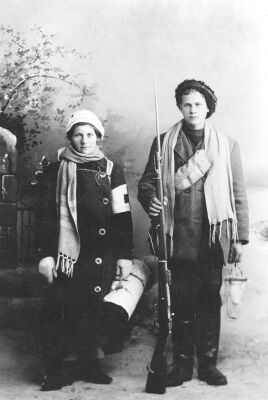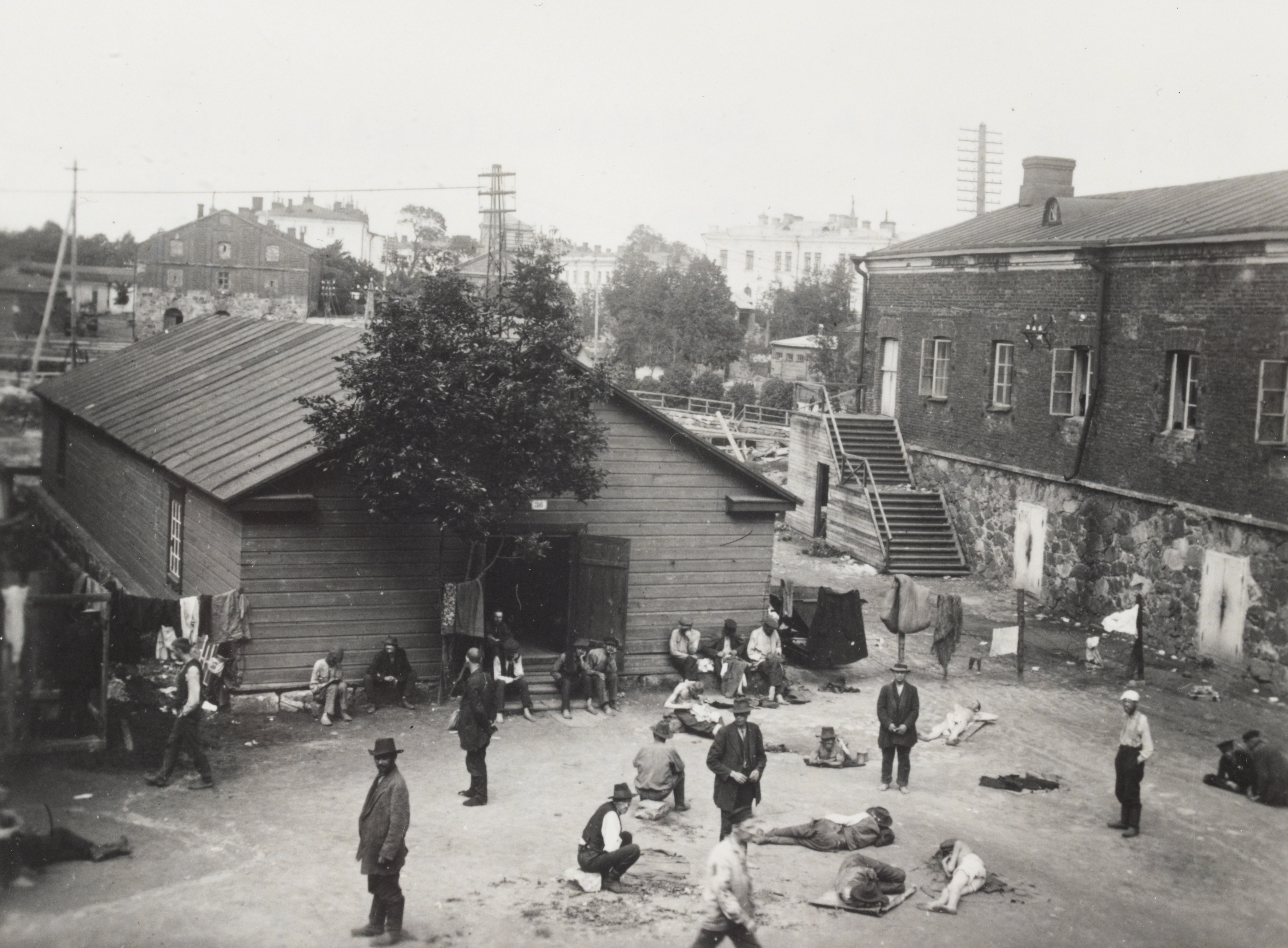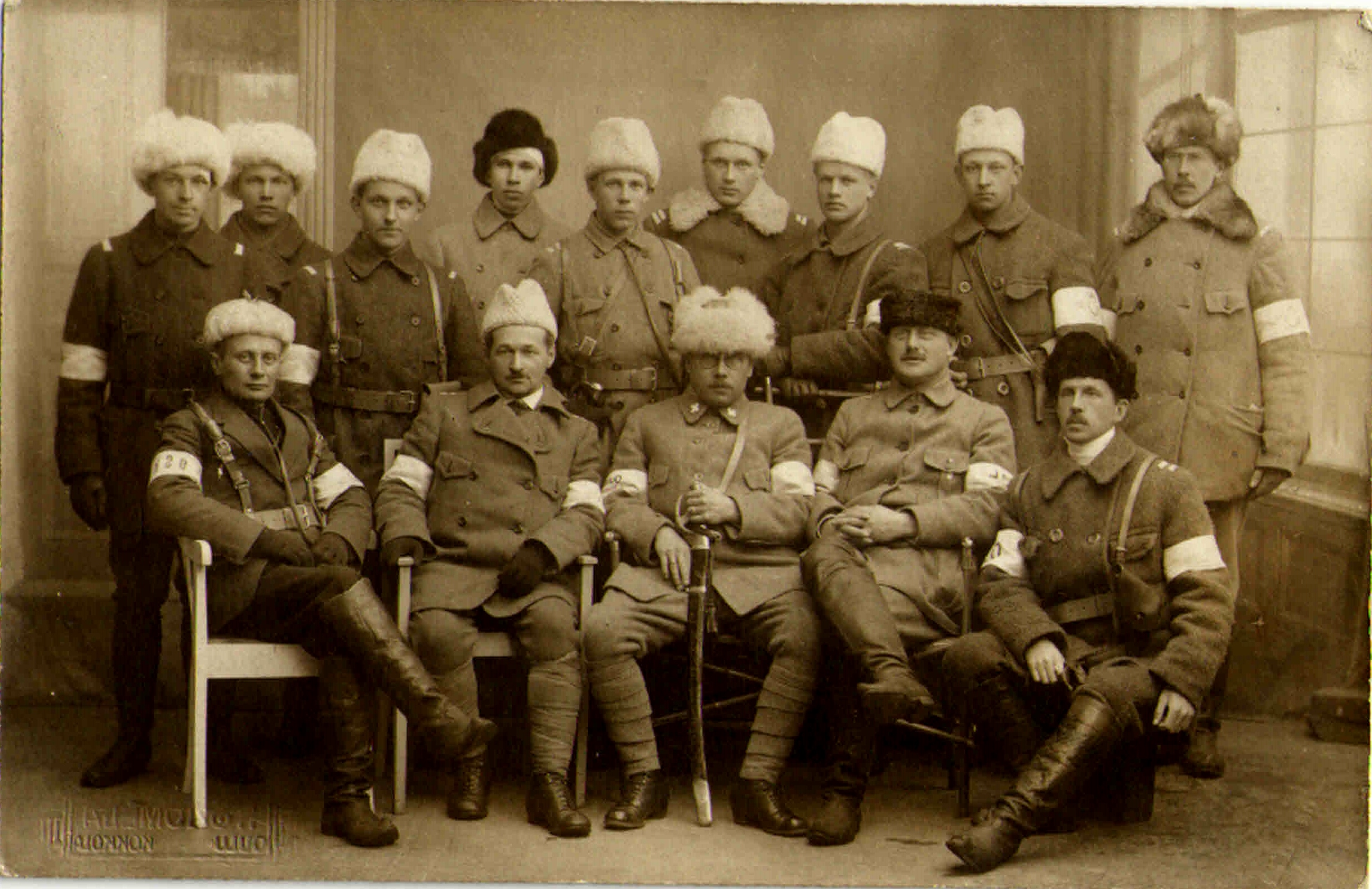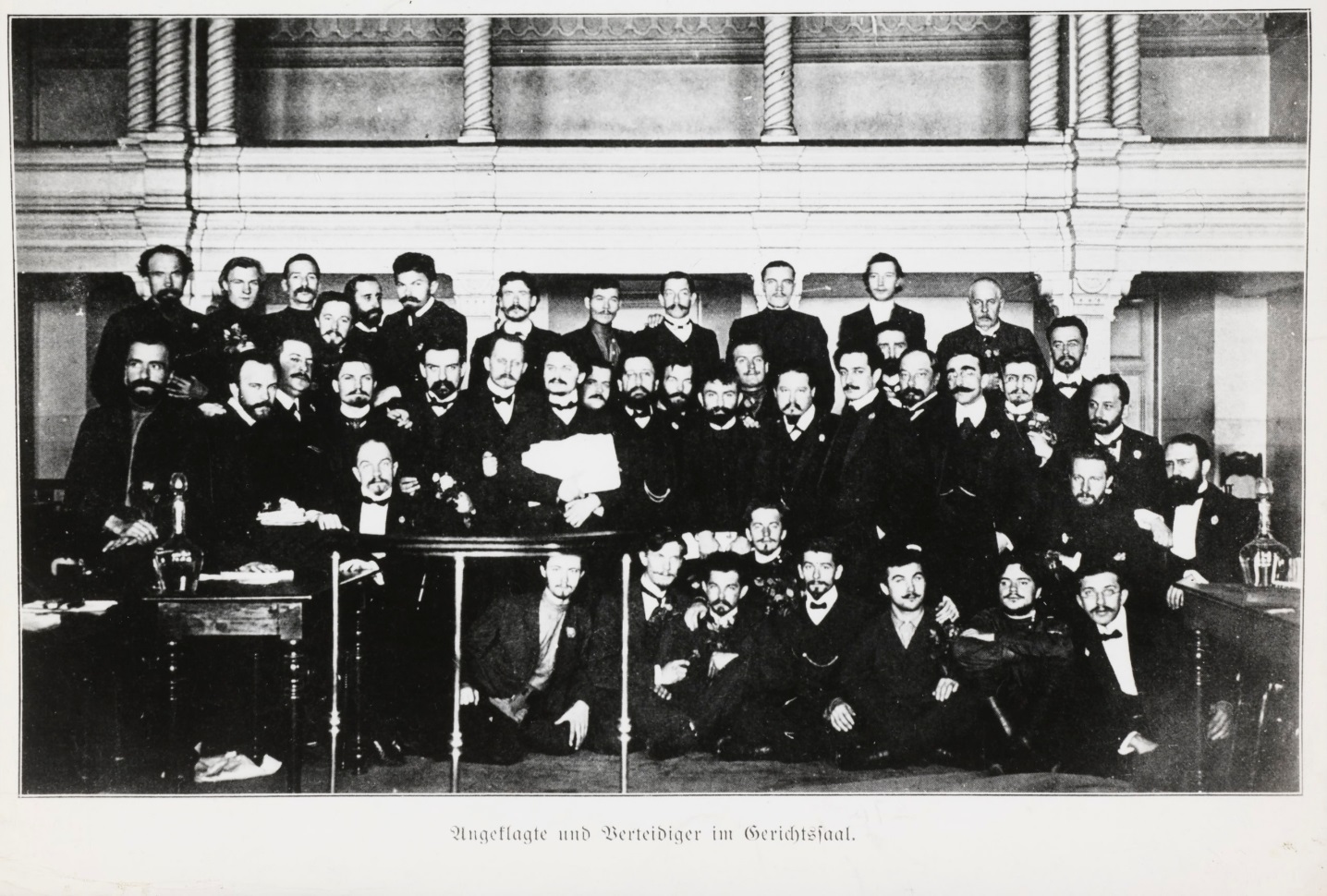|
Finnish Red Guard
The Red Guards (, ; ) were the paramilitary units of the labour movement in Finland during the early 1900s. The Red Guards formed the army of Red Finland and were one of the main belligerents of the Finnish Civil War in 1918. The Red Guards were first established during the Finnish general strike of 1905, 1905 general strike but disbanded a year later until they were re-established after the February Revolution in 1917. The combined strength of the Red Guard was about 30,000 at the beginning of the Civil War, peaking at between 90,000 and 120,000 during the course of the conflict, including more than 2,000 members of the Women's Red Guards of the Finnish Civil War, Women's Guards. The Red Guards were defeated in Finland by the Whites (Finland), Whites in May 1918 and around 80,000 were captured as prisoners of war, where 12,000 to 14,000 of them died in the Finnish Civil War prison camps, post-war prison camps due to disease, malnutrition, and Capital punishment, execution. Mos ... [...More Info...] [...Related Items...] OR: [Wikipedia] [Google] [Baidu] |
Russian Revolution Of 1905
The Russian Revolution of 1905, also known as the First Russian Revolution, was a revolution in the Russian Empire which began on 22 January 1905 and led to the establishment of a constitutional monarchy under the Russian Constitution of 1906, the country's first. The revolution was characterized by mass political and social unrest including worker strikes, peasant revolts, and military mutinies directed against Tsar Nicholas II and the autocracy, who were forced to establish the State Duma legislative assembly and grant certain rights, though both were later undermined. In the years leading up to the revolution, impoverished peasants had become increasingly angered by repression from their landlords and the continuation of semi-feudal relations. Further discontent grew due to mounting Russian losses in the Russo-Japanese War, poor conditions for workers, and urban unemployment. On , known as " Bloody Sunday", a peaceful procession of workers was fired on by guards outside th ... [...More Info...] [...Related Items...] OR: [Wikipedia] [Google] [Baidu] |
White Guard (Finland)
The White Guard, officially known as the Civil Guard (, ; ; ), was a voluntary militia, part of the Finnish Whites movement, that emerged victorious over the socialist Red Guards in the Finnish Civil War of 1918. They were generally known as the "White Guard" in the West due to their opposition to the "communist" Red Guards. In the White Army of Finland many participants were recruits, draftees and German-trained Jägers – rather than part of the paramilitary. The central organization was named the White Guard Organization, and the organization consisted of local chapters in municipalities. The Russian Revolution of 1905 led to social and political unrest and a breakdown of security in Finland, which was then a Grand Duchy under the rule of the Russian Tsar. Citizen militias formed as a response, but soon these would be transformed along political (left-right) lines. The Russian Revolution of 1917 and the subsequent independence of Finland (declared in December 1917) a ... [...More Info...] [...Related Items...] OR: [Wikipedia] [Google] [Baidu] |
Capital Punishment
Capital punishment, also known as the death penalty and formerly called judicial homicide, is the state-sanctioned killing of a person as punishment for actual or supposed misconduct. The sentence (law), sentence ordering that an offender be punished in such a manner is called a death sentence, and the act of carrying out the sentence is an execution. A prisoner who has been sentenced to death and awaits execution is ''condemned'' and is commonly referred to as being "on death row". Etymologically, the term ''capital'' (, derived via the Latin ' from ', "head") refers to execution by Decapitation, beheading, but executions are carried out by List of methods of capital punishment, many methods, including hanging, Execution by shooting, shooting, lethal injection, stoning, Electric chair, electrocution, and Gas chamber, gassing. Crimes that are punishable by death are known as ''capital crimes'', ''capital offences'', or ''capital felonies'', and vary depending on the jurisdic ... [...More Info...] [...Related Items...] OR: [Wikipedia] [Google] [Baidu] |
Malnutrition
Malnutrition occurs when an organism gets too few or too many nutrients, resulting in health problems. Specifically, it is a deficiency, excess, or imbalance of energy, protein and other nutrients which adversely affects the body's tissues and form. Malnutrition is a category of diseases that includes undernutrition and overnutrition. Undernutrition is a lack of nutrients, which can result in stunted growth, wasting, and being underweight. A surplus of nutrients causes overnutrition, which can result in obesity or toxic levels of micronutrients. In some developing countries, overnutrition in the form of obesity is beginning to appear within the same communities as undernutrition. Most clinical studies use the term 'malnutrition' to refer to undernutrition. However, the use of 'malnutrition' instead of 'undernutrition' makes it impossible to distinguish between undernutrition and overnutrition, a less acknowledged form of malnutrition. Accordingly, a 2019 report by The Lance ... [...More Info...] [...Related Items...] OR: [Wikipedia] [Google] [Baidu] |
Finnish Civil War Prison Camps
Finnish Civil War prison camps were operated by the White Finns to hold prisoners of war during and after the Finnish Civil War in 1918. Around 80,000 captured Red Guards and their families, including 4,700 women and 1,500 children, were held in prisoner of war camps across Finland.Red Prisoners MANNERHEIM – War of Independence. Retrieved 9 February 2015. University of Tampere. Retrieved 9 February 2015. They were composed of 13 main camps and more than 60 smaller sub-camps operated by the White Army during the summer of 1918. Conditions were very poor and camps suffered from high |
Prisoners Of War
A prisoner of war (POW) is a person held captive by a belligerent power during or immediately after an armed conflict. The earliest recorded usage of the phrase "prisoner of war" dates back to 1610. Belligerents hold prisoners of war for a range of legitimate and illegitimate reasons. These may include isolating them from enemy combatants still in the field (releasing and repatriating them in an orderly manner after hostilities), demonstrating military victory, punishment, prosecution of war crimes, labour exploitation, recruiting or even conscripting them as combatants, extracting collecting military and political intelligence, and political or religious indoctrination. Ancient times For much of history, prisoners of war would often be slaughtered or enslaved. Early Roman gladiators could be prisoners of war, categorised according to their ethnic roots as Samnites, Thracians, and Gauls (''Galli''). Homer's ''Iliad'' describes Trojan and Greek soldiers offering rewards o ... [...More Info...] [...Related Items...] OR: [Wikipedia] [Google] [Baidu] |
Whites (Finland)
White Finland (officially known simply as Finland) is the name given to the anti-communist Refugee government, refugee and provisional government declared in Grand Duchy of Finland, Finland following the October Revolution. Its forces, known as the Finnish White Guard, Whites (, ; , ), led by Carl Gustaf Emil Mannerheim, fought against the forces of the rival Finnish Socialist Workers' Republic, known as the "Finnish Red Guard, Reds", during the Finnish Civil War in 1918. At the start of the civil war, the Whites controlled the majority of Finland's territory, chiefly its central and northern areas. These were largely rural areas however, and most industrial centres, including the capital of Helsinki, were under Red control, forcing Pehr Evind Svinhufvud's first senate, the senate to relocate to the coastal city of Vaasa. Imperial German support, coupled with a comparatively lacklustre Soviet Russia, Soviet support for the Finnish Reds helped the Finnish Whites ultimately win th ... [...More Info...] [...Related Items...] OR: [Wikipedia] [Google] [Baidu] |
Women's Red Guards Of The Finnish Civil War
All-female units of the paramilitary Red Guards (Finland), Red Guards served in the 1918 Finnish Civil War. The first Women's Guards units formed in early February in the main Finnish cities. More than 15 female Guards units were established by the end of March 1918, with a total of about 2,000 women serving. The female Guards units consisted of young industrial workers, maids, and servants. Their average age was about 20, but some were as young as 14. The women served in auxiliary units in combat. By joining the Red Guards, women stepped out of their traditional role in Finnish society and were demonized by the Whites (Finland), Whites, the anti-Communist paramilitary. The Red commanders were reluctant to commit the female Guards units to battle and usually held them in reserve. Towards the end of the war, several saw combat. During the Battle of Tampere, the city hall was the last pocket of Red resistance; there is a legend that this was because while the male defenders wanted ... [...More Info...] [...Related Items...] OR: [Wikipedia] [Google] [Baidu] |
February Revolution
The February Revolution (), known in Soviet historiography as the February Bourgeois Democratic Revolution and sometimes as the March Revolution or February Coup was the first of Russian Revolution, two revolutions which took place in Russia in 1917. The main events of the revolution took place in and near Petrograd (now Saint Petersburg), the then-capital of Russia, where long-standing discontent with the monarchy erupted into mass protests against food rationing on 23 February Old Style and New Style dates, Old Style (8 March Old Style and New Style dates, New Style). Revolutionary activity lasted about eight days, involving mass demonstrations and violent armed clashes with police and Special Corps of Gendarmes, gendarmes, the last loyal forces of the Russian monarchy. On 27 February O.S. (12 March N.S.), most of the forces of the capital's garrison sided with the revolutionaries. In the same day, the Russian Provisional Government, made up by left-leaning State Duma (Russ ... [...More Info...] [...Related Items...] OR: [Wikipedia] [Google] [Baidu] |
Finnish General Strike Of 1905
The Russian Revolution of 1905, also known as the First Russian Revolution, was a revolution in the Russian Empire which began on 22 January 1905 and led to the establishment of a constitutional monarchy under the Russian Constitution of 1906, the country's first. The revolution was characterized by mass political and social unrest including worker strike action, strikes, peasant revolts, and military mutiny, mutinies directed against Tsar Nicholas II and the Tsarist autocracy, autocracy, who were forced to establish the State Duma (Russian Empire), State Duma legislative assembly and grant certain rights, though both were later undermined. In the years leading up to the revolution, impoverished peasants had become increasingly angered by repression from their Landlord, landlords and the continuation of semi-feudal relations. Further discontent grew due to mounting Russian losses in the Russo-Japanese War, poor conditions for workers, and urban unemployment. On , known as "Bloody ... [...More Info...] [...Related Items...] OR: [Wikipedia] [Google] [Baidu] |
Red Finland
The Finnish Socialist Workers' Republic (FSWR), more commonly referred to as Red Finland, was a self-proclaimed socialist state in Finland during the Finnish Civil War from January to May 1918. The FSWR was established by the Finnish People's Delegation, a government formed by members of the Social Democratic Party of Finland, Social Democratic Party to rival the existing Government of Finland, with support of the Red Guards (Finland), Red Guards. The FSWR controlled the capital Helsinki and most of southern Finland until March. Kullervo Manner served as its sole leader as Chairman of the Central Committee of the Finnish People's Delegation. The FSWR collapsed when the Red Guards were defeated by the Whites (Finland), White Finns and German Empire, Germany, with Manner and most of the Finnish People's Delegation fleeing to Soviet Russia. The name "Finnish Socialist Workers' Republic" () appeared only in the Treaty between Finnish People's Delegation and Russian Council of People ... [...More Info...] [...Related Items...] OR: [Wikipedia] [Google] [Baidu] |
Labour Movement
The labour movement is the collective organisation of working people to further their shared political and economic interests. It consists of the trade union or labour union movement, as well as political parties of labour. It can be considered an instance of class conflict. * In trade unions, workers campaign for higher wages, better working conditions and fair treatment from their employers, and through the implementation of labour laws, from their governments. They do this through collective bargaining, sectoral bargaining, and when needed, strike action. In some countries, co-determination gives representatives of workers seats on the board of directors of their employers. * Political parties representing the interests of workers campaign for labour rights, social security Welfare spending is a type of government support intended to ensure that members of a society can meet basic human needs such as food and shelter. Social security may either be synonymous with w ... [...More Info...] [...Related Items...] OR: [Wikipedia] [Google] [Baidu] |









